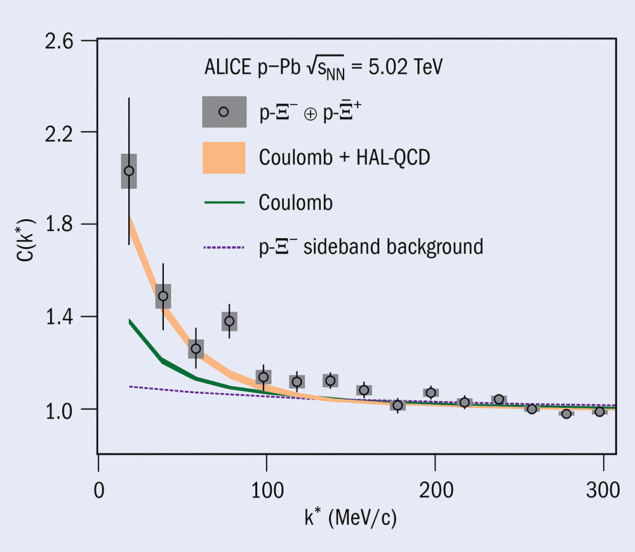A report from the ALICE experiment

Neutron stars consist of extremely dense nuclear matter. Their maximum size and mass are determined by their equation of state, which in turn depends on the interaction potentials between nucleons. Due to the high density, not only neutrons but also heavier strange baryons may play a role.
The main experimental information on the interaction potentials between nucleons and strange baryons comes from bubble-chamber scattering experiments with strange-hadron beams undertaken at CERN in the 1960s, and is limited in precision due to the short lifetimes (< 200 ps) of the hadrons. The ALICE collaboration is now using the scattering between particles produced in collisions at the LHC to constrain interaction potentials in a new way. So far, pK–, pΛ, pΣ0, pΞ– and pΩ– interactions have been investigated. Recent data have already yielded the first evidence for a strong attractive interaction between the proton and the Ξ– baryon.
Strong final-state interactions between pairs of particles make their momenta more parallel to each other in the case of an attractive interaction, and increase the opening angle between them in the case of a repulsive interaction. The attractive potential of the p-Ξ– interaction was observed by measuring the correlation of pairs of protons and Ξ– particles as a function of their relative momentum (the correlation function) and comparing it with theoretical calculations based on different interaction potentials. This technique is referred to as “femtoscopy” since it simultaneously measures the size of the region in which particles are produced and the interaction potential between them.
Data from proton–lead collisions at a centre-of-mass energy per nucleon pair of 5.02 TeV show that p-Ξ– pairs are produced at very small distances (~1.4 fm); the measured correlation is therefore sensitive to the short-range strong interaction. The measured p-Ξ– correlations were found to be stronger than theoretical correlation functions with only a Coulomb interaction, whereas the prediction obtained by including both the Coulomb and strong interactions (as calculated by the HAL-QCD collaboration) agrees with the data (figure 1).
As a first step towards evaluating the impact of these results on models of neutron-star matter, the HAL-QCD interaction potential was used to compute the single-particle potential of Ξ– within neutron-rich matter. A slightly repulsive interaction was inferred (of the order of 6 MeV, compared to the 1322 MeV mass of the Ξ–), leading to better constraints on the equation of state for dense hadronic systems that contain Ξ– particles. This is an important step towards determining the equation of state for dense and cold nuclear matter with strange hadrons.
Further reading
ALICE Collaboration 2019 arXiv:1904.12198.








